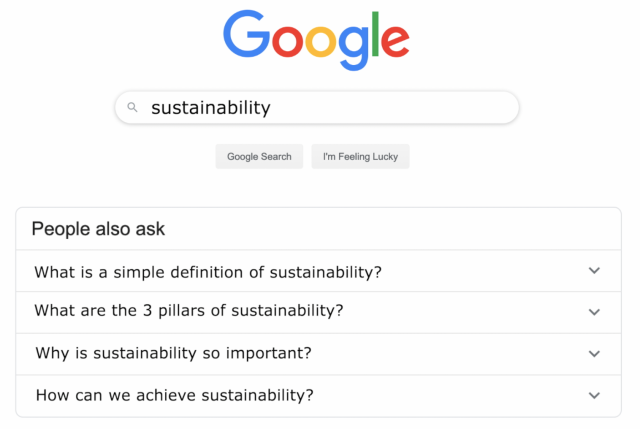
Answering the 4 most searched questions about sustainability on Google
You must have heard this word Sustainability a lot over the past few years. I know I did… But what is a simple definition of sustainability?
Here is a guide to help you get more comfortable with what sustainability is… and is not.
It will respond to the four following questions:
- What is a simple definition of sustainability?
- What are the 3 principles/pillars of sustainability?
- Why is sustainability so important?
- How can we achieve sustainability?
Simple definition of sustainability
Sustainability is the capacity of our human society to continue indefinitely within Earth’s natural cycles.
This is my favourite definition of sustainability by far as it describes a clear goal that we can work toward.
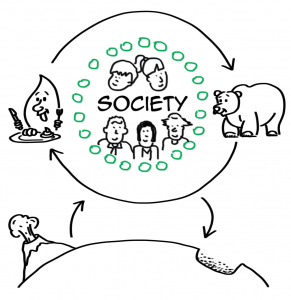
In that sense, a sustainable development is a development that leads toward full sustainability.
It makes sense so far, right!?
Sustainable development was also defined by the Brundtland commission:
Sustainable development is development that meets the needs of the present without compromising the ability of future generations to meet their own needs.
Over the years, the lack of common language or definition of sustainability has been an issue. And it is hard for a group of people to do good work on something when they don’t agree on what it means. Therefore…
In 1989, a Swedish scientist thought “what if we managed to get a group of scientists together and to agree on what sustainability means, based on science and thermodynamics?” So he did. After many drafts, a group of 50 scientists agreed on a few key things:
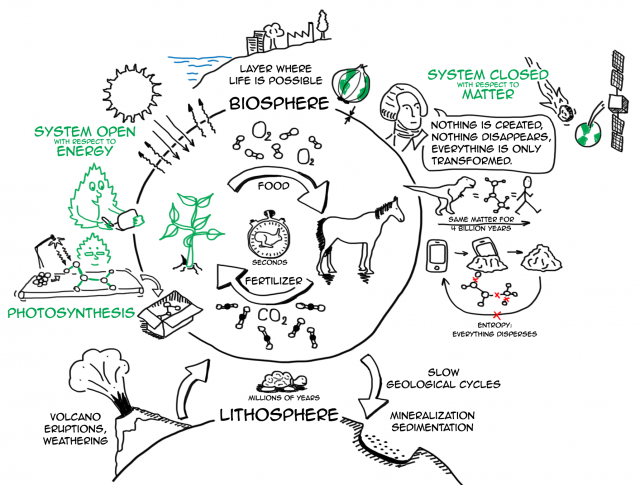 There are quick and well balanced natural cycles happening inside the biosphere (the thin layer on the surface of the earth where life is possible): Plants produce oxygen and food which are consumed by the animals. In return, animals produce fertilizer and carbon dioxide (CO2) which are used by the plants.
There are quick and well balanced natural cycles happening inside the biosphere (the thin layer on the surface of the earth where life is possible): Plants produce oxygen and food which are consumed by the animals. In return, animals produce fertilizer and carbon dioxide (CO2) which are used by the plants.- The biosphere is open with respect to energy: energy from the sun comes in and radiations go out. This is also known as the first law of thermodynamics.
- The biosphere is closed with respect to matter: over 4 billion years, no matter has come in or out. This is also known as the law of conservation of matter.
- Everything has a tendency to disperse (also known as the law of entropy).
- Photosynthesis pays the bills: it reorganizes matter and creates new structure thanks to plants’ capacity to use the energy from the sun to produce oxygen and sugar using carbon dioxide and water.
- Slow and well balanced geological cycles exchange matter between the lithosphere (the earth’s crust) to the biosphere: volcano eruptions, weathering, mineralization, sedimentation, etc.
This is grade 6 science for the most part.
How does this help us understand the definition of sustainability?
This scientific consensus made it possible for the group of scientists to look at the things that we (humans) do to interfere with these natural cycles. They found four root causes of un-sustainability:
- We extract large flows of materials from the Earth’s crust.
- We create an accumulation of substances produced by society.
- We physically inhibit nature’s ability to run its cycles and…
- We create barriers to people meeting their basic needs worldwide.
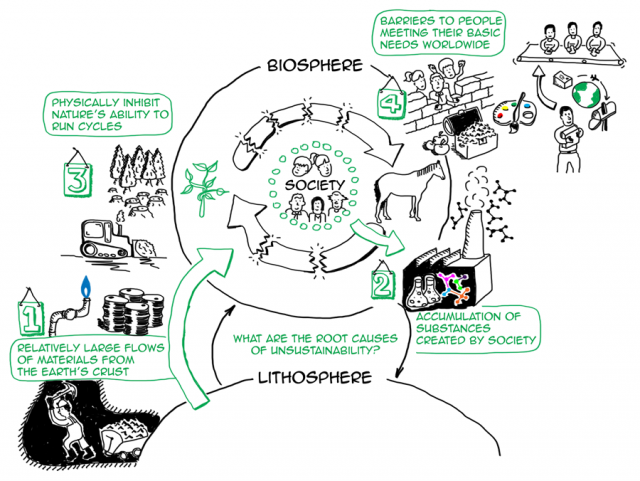
The first three speak to the environment while the fourth one is more social.
But, I am getting ahead of myself… We will talk about these again down below, under “How can we achieve sustainability?”.
The animation video below explains what sustainability is, presents the scientific consensus as well as the root causes of un-sustainability.
The 3 pillars of sustainability: another definition
Sustainability is often presented as having 3 pillars: economic, social and environmental. This is also known as the “Triple Bottom Line“, particularly when talking about sustainability and business. The phrase was coined by John Elkington in 1994.
The concept is often described as three overlapping circles.
Sustainability is typically defined as the place where economy, social realities and environmental health overlap.
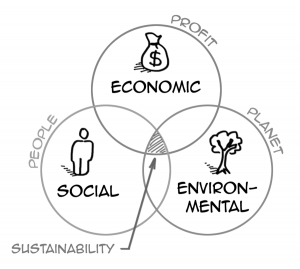 But the scientific consensus presented above tells us that, left to its own devices, the planet operates in a balanced way. Photosynthesis “pays the bills”. Without it, creation of structure from energy would not occur, and entropy could rule the day.
But the scientific consensus presented above tells us that, left to its own devices, the planet operates in a balanced way. Photosynthesis “pays the bills”. Without it, creation of structure from energy would not occur, and entropy could rule the day.
Plant cells belong to the environment circle of the triple bottom line. If plant cells are the original creators of structure, then this is the circle on which everything else depends, or in which everything is embedded. Everything comes from nature at some point. Society, which is related to the social circle of the triple bottom line, exists within the environment. And economy is a by-product of society. Instead of three overlapping circles, we have three nested circles, where the economy is a wholly owned subsidiary of the environment.
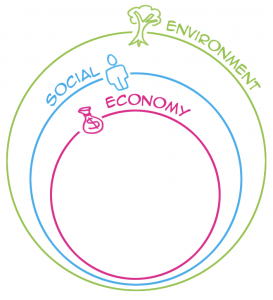 Why is sustainability so important?
Why is sustainability so important?
Being humans’ capacity to survive within Earth’s natural cycles, sustainability is important because it is the only alternative to human extinction.
Wow! Really?! I know, we don’t hear about human extinction every day. But let’s be honest about it.
Here is a way to explain how important sustainability is in a good and useful way: the metaphor of a funnel.
On the one hand: the Earth’s capacity to provide what we need is declining. There are fewer forests and fish today than there were 100 years ago. This affects the ability of the planet to supply ‘ecosystems services’ (the things that are necessary to support life and on which we rely, such as climate regulation, water filtration, soil generation, etc).
On the other hand: the rate at which we consume resources and generate waste is going up.
But that’s not all!
- Growing consumer awareness makes consumers expect new behaviour from corporations and governments;
- Governments are changing laws that are getting stricter;
- Trust between people is declining;
- Prices are going up;
- Abuse of power leads to growing inequality around the world, resulting in more social tension;
- The world’s population is growing;
- etc.
 It looks like all these trends are converging, right!? And we don’t want to see what happens if or when they meet.
It looks like all these trends are converging, right!? And we don’t want to see what happens if or when they meet.
It is as if we were going deeper into a funnel: the pressure is increasing overtime and we have less and less margin to maneuver.
We all know examples of “hitting the walls of the funnel”: Nike when Greenpeace exposed their poor labour practices in developing countries, the city of Detroit due to economic recession, the Easter island civilization that disappeared after what seems to have been the destruction of their environment.
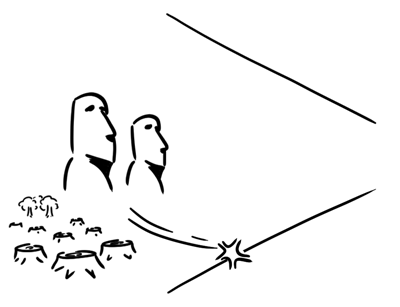 The animation video below explains the funnel metaphor into more details.
The animation video below explains the funnel metaphor into more details.
How can we achieve sustainability?
By meeting human needs within ecological constraints.
Using the metaphor of the funnel, sustainability can be achieved by ‘opening the funnel’ walls to create a resilient, fulfilling and accessible society that can thrive within nature’s limits.
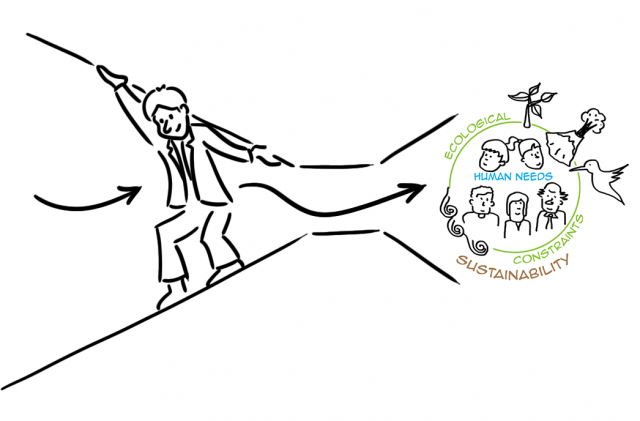 From a more scientific perspective, sustainability can be achieved by stopping our contribution to the 4 root causes of un-sustainability we introduced above.
From a more scientific perspective, sustainability can be achieved by stopping our contribution to the 4 root causes of un-sustainability we introduced above.
I other words, to become a sustainable society, we must eliminate our contributions to…
- the systematic increase of concentrations of substances extracted from the Earth’s crust (for example heavy metals and fossil fuels)
- the systematic increase of concentrations of substances produced by society (for example plastics, dioxins, PCBs and DDT)
- the systematic physical degradation of nature and natural processes (for example over-harvesting forests, destroying habitat and overfishing); and…
- conditions that systematically undermine people’s capacity to meet their basic human needs (for example, unsafe working conditions and not enough pay to live on).
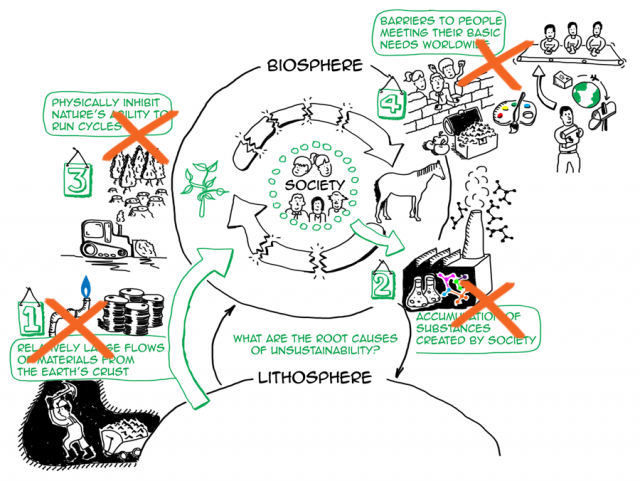 There is also a video explaining these principles in more details.
There is also a video explaining these principles in more details.
These principles are very flexible and can be applied at multiple scales, to a person, a family, a business, a community or even to a nation.
Now that you know the fundamentals, you can learn a lot more about sustainability by watching our other animation videos.
Was that helpful?
Please leave us your questions and comments below so we can improve this guide for everybody.



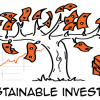

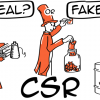

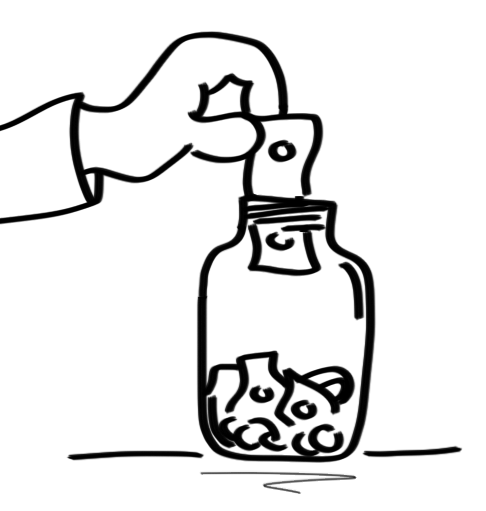
Great page here Alex, love your work and hope to use it more like we have talked about in my classes and publications.
Bo
Thanks Bo! I am glad it is helpful!
Hi Alex, Thank you so much for your amazing videos. The clarity they bring to a confusing subject just shows how knowledgable and talented you are.
I have been watching your videos as part of a Sustainable Living Course at UTAS and I am intrigued to know more about the Swedish scientist you mention and the group of 50 scientists who produced the fundamental root causes of unsustainability. Would you be able to enlighten me as to there name and the name of the work they produced?
Many thanks,
Eric
Hi Eric,
Thank you for your message.
His name is Karl-Henrik Robèrt. You will easily find information about him online. He is the founder of a non-profit called The Natural Step and he (with some other fellow scientists) put together the Framework for Strategic Sustainable Development (FSSD). He also teaches at a master’s program in Sweden that I attended in 2006: http://bth.se/msls.
Best, Alex